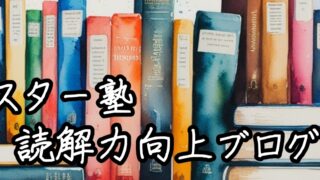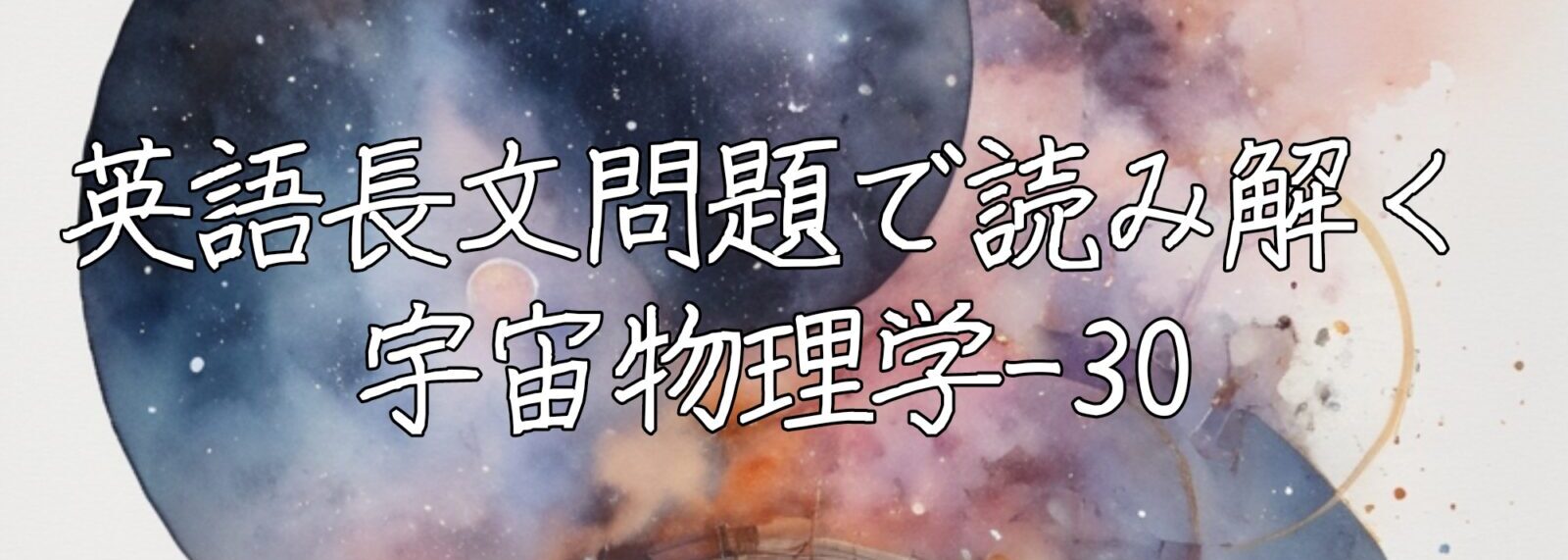英検2級レベルの英語長文問題を読み解きながら、宇宙物理学の基本的な知識を身につけることが出来る問題集をkindleにて出版しました!
各種英語検定試験、特に、TOEFL ibtのような専門性も求められるリーディング問題の対策になる長文問題集です!

英語長文問題で読み解く宇宙物理学-30: 宇宙物理学の重要テーマを英語で読み解く 英語長文問題で読み解く学問シリーズ
これまでに発売した英語の長文問題集の一覧はコチラから!
英語長文で読み解く宇宙物理学-30 の中身を公開!
以下、どんな内容になっているのかを公開します!
目次
はじめに
1.重力波 – 空間の歪みが波として伝わる現象。
2.イベントホライズン – ブラックホールの境界。
3.宇宙背景放射 – ビッグバン後の名残の微弱な放射。
4.一般相対性理論 – アインシュタインが提唱した重力の理論。
5.特殊相対性理論 – アインシュタインが提唱した光速一定の理論。
6.宇宙膨張 – 宇宙が時間とともに広がっている現象。
7.ハッブル定数 – 宇宙膨張の速度を表す定数。
8.ビッグリップ – 宇宙の加速膨張がすべてを引き裂く仮説。
9.ビッグクランチ – 宇宙が収縮して一点に戻る仮説。
10.ビッグバウンス – 宇宙が膨張と収縮を繰り返す仮説。
11.インフレーション理論 – 初期宇宙の急激な膨張を説明する理論。
12.宇宙の大規模構造 – 宇宙全体の銀河や物質の分布。
13.重力レンズ効果 – 重力によって光が曲げられる現象。
14.マイクロレンズ効果 – 小さな天体による重力レンズ効果。
15.宇宙の年齢 – 宇宙が誕生してからの時間。
16.宇宙加速度 – 宇宙膨張の加速。
17.フラット宇宙 – 宇宙の空間が平坦であるという仮説。
18.開いた宇宙 – 宇宙が無限に膨張する仮説。
19.閉じた宇宙 – 宇宙がやがて収縮する仮説。
20.量子重力 – 量子力学と重力を統一する理論。
21.弦理論 – 基本的な粒子が一つの「弦」でできているという理論。
22.多元宇宙 – 複数の宇宙が存在するという仮説。
23.ホログラフィック原理 – 空間の情報がその境界に格納されているという仮説。
24.熱死 – 宇宙が最終的に熱的平衡に達する状態。
25.エキゾチック物質 – 負のエネルギー密度を持つ仮説的物質。
26.宇宙線 – 宇宙から地球に降り注ぐ高エネルギー粒子。
27.ガンマ線バースト – 宇宙で発生する非常に強いガンマ線の閃光。
28.宇宙の階層構造 – 小さな構造が集まって大きな構造を形成する。
29.エネルギーの保存 – エネルギーが時間とともに変わらない法則。
30.質量の保存 – 質量が時間とともに変わらない法則。
1.重力波 – 空間の歪みが波として伝わる現象。
Gravitational Waves: Ripples in the Fabric of Spacetime
Gravitational waves are one of the most fascinating phenomena in astrophysics. Predicted by Albert Einstein in his general theory of relativity in 1916, these waves are ripples in the fabric of spacetime caused by some of the most violent and energetic processes in the universe. For nearly a century after their prediction, gravitational waves remained elusive, with scientists struggling to detect them directly. However, in recent years, breakthroughs in technology and scientific understanding have finally allowed us to observe these cosmic ripples, opening up a new era in astronomy.
To understand gravitational waves, we must first grasp the concept of spacetime. In Einstein’s theory, space and time are not separate entities but are woven together into a four-dimensional fabric called spacetime. Massive objects, like stars and planets, cause this fabric to curve, creating what we experience as gravity. When extremely massive objects accelerate or collide, they create ripples in spacetime that spread outward like waves on a pond. These are gravitational waves.
The challenge in detecting gravitational waves lies in their incredibly weak nature. Even the strongest gravitational waves from cosmic events cause tiny distortions in spacetime. For example, a gravitational wave passing through Earth might change its diameter by less than the width of an atomic nucleus. This extreme subtlety is why gravitational waves eluded direct detection for so long.
The breakthrough came on September 14, 2015, when the Laser Interferometer Gravitational-Wave Observatory (LIGO) made the first direct observation of gravitational waves. This historic detection came from the merger of two black holes, each about 30 times the mass of our Sun, located 1.3 billion light-years away. The collision released an enormous amount of energy, briefly outshining all the stars in the observable universe combined.
LIGO’s detection was made possible by its incredibly sensitive instruments. The observatory uses laser interferometers, which split a laser beam and send it down two perpendicular 4-kilometer-long tunnels. The beams are reflected back by mirrors and recombined. If a gravitational wave passes through, it slightly changes the length of one tunnel relative to the other, creating a detectable interference pattern in the recombined laser light.
Since the first detection, scientists have observed numerous other gravitational wave events. These include more black hole mergers, as well as the collision of neutron stars. The neutron star merger, detected in August 2017, was particularly exciting because it was also observed by traditional telescopes, ushering in the era of “multi-messenger astronomy.”
Gravitational wave astronomy offers several advantages over traditional observational methods. Unlike light, gravitational waves can pass through matter unimpeded, allowing us to observe events that would otherwise be hidden. They also carry information about the inner workings of the events that produce them, providing insights into the physics of extreme cosmic phenomena.
The future of gravitational wave astronomy is bright. Plans are underway for more advanced detectors on Earth and even in space. The European Space Agency’s LISA (Laser Interferometer Space Antenna) mission, scheduled for the 2030s, will detect gravitational waves from space, free from Earth-based interference.
The study of gravitational waves has already yielded remarkable discoveries. It has provided the strongest evidence yet for the existence of black holes and has allowed us to test general relativity in extreme conditions. In the coming years, gravitational wave astronomy promises to reveal more about the nature of gravity, the properties of matter at extreme densities, and perhaps even the early moments of the universe itself.
As we continue to listen to the cosmic symphony of gravitational waves, we are opening new windows onto the universe, hearing its secrets in ways we never could before. This field represents one of the most exciting frontiers in modern science, promising to revolutionize our understanding of the cosmos and our place within it.
注釈
- Gravitational waves (重力波): 時空の歪みが波として伝わる現象。
- Spacetime (時空): アインシュタインの相対性理論で提唱された、空間と時間が一体となった4次元の概念。
- General theory of relativity (一般相対性理論): アインシュタインが提唱した、重力を時空の歪みとして説明する理論。
- Atomic nucleus (原子核): 原子の中心にある、陽子と中性子からなる部分。
- Laser Interferometer Gravitational-Wave Observatory (LIGO) (レーザー干渉計重力波観測所): 重力波を検出するための施設。
- Black hole (ブラックホール): 重力が非常に強く、光さえも脱出できない天体。
- Neutron star (中性子星): 超新星爆発の後に残る、非常に密度の高い恒星の残骸。
- Multi-messenger astronomy (マルチメッセンジャー天文学): 重力波、電磁波、ニュートリノなど複数の情報源を用いて天体現象を研究する手法。
- LISA (Laser Interferometer Space Antenna) (レーザー干渉計宇宙アンテナ): 宇宙空間で重力波を観測するための計画中のミッション。
設問
- What are gravitational waves according to the passage?
A) Light waves from distant galaxies
B) Ripples in the Earth’s atmosphere
C) Vibrations in the core of planets
D) Ripples in the fabric of spacetime - Who first predicted the existence of gravitational waves?
A) Isaac Newton
B) Albert Einstein
C) Stephen Hawking
D) Galileo Galilei - Why were gravitational waves difficult to detect for so long?
A) They don’t exist in our solar system
B) They are extremely weak
C) They only occur once every century
D) They can only be observed from space - What event led to the first direct observation of gravitational waves?
A) A supernova explosion
B) The collision of two planets
C) The merger of two black holes
D) The birth of a new star - How does LIGO detect gravitational waves?
A) By observing changes in star brightness
B) By measuring variations in Earth’s magnetic field
C) By using laser interferometers
D) By analyzing radio waves from space - What is one advantage of gravitational wave astronomy over traditional methods?
A) It’s cheaper to build gravitational wave detectors
B) Gravitational waves can pass through matter unimpeded
C) Gravitational waves travel faster than light
D) Gravitational wave detectors are more accurate in measuring star temperatures - What is “multi-messenger astronomy” as mentioned in the passage?
A) Using multiple telescopes to observe the same object
B) Combining data from gravitational waves and traditional telescopes
C) Sending messages between different observatories
D) Using multiple satellites to detect cosmic rays - What is LISA, as described in the passage?
A) A new type of optical telescope
B) A planned space-based gravitational wave detector
C) A supercomputer for analyzing astronomical data
D) A mission to study black holes up close - According to the passage, what has the study of gravitational waves provided evidence for?
A) The existence of alien life
B) The age of the universe
C) The existence of black holes
D) The composition of distant planets - How might gravitational wave astronomy contribute to our understanding of the universe in the future?
A) By providing insights into the early moments of the universe
B) By helping us communicate with extraterrestrial civilizations
C) By enabling faster-than-light travel
D) By predicting future cosmic events with perfect accuracy
解答・解説
- 本文によると、重力波とは何ですか?
A) 遠い銀河からの光波
B) 地球の大気中の波
C) 惑星の核の振動
D) 時空の織物の中のさざ波
正解: D
説明: 本文では、重力波は時空の織物の中のさざ波(ripples in the fabric of spacetime)と定義されています。これはアインシュタインの一般相対性理論に基づく概念です。
- 重力波の存在を最初に予測したのは誰ですか?
A) アイザック・ニュートン
B) アルバート・アインシュタイン
C) スティーヴン・ホーキング
D) ガリレオ・ガリレイ
正解: B
説明: 本文によると、アルバート・アインシュタインが1916年に一般相対性理論の中で重力波を予測しました。
- なぜ重力波は長い間検出が困難だったのですか?
A) 太陽系内に存在しないから
B) 極めて弱いから
C) 100年に一度しか発生しないから
D) 宇宙からしか観測できないから
正解: B
説明: 本文では、重力波の検出が困難だった理由として、その影響が極めて微弱であることが挙げられています。例えば、地球を通過する重力波による変化は原子核の幅よりも小さいとされています。
- 重力波の最初の直接観測につながったのはどのような出来事ですか?
A) 超新星爆発
B) 2つの惑星の衝突
C) 2つのブラックホールの合体
D) 新しい星の誕生
正解: C
説明: 本文によると、2015年9月14日にLIGOが観測した2つのブラックホールの合体が、重力波の最初の直接観測となりました。
- LIGOはどのように重力波を検出しますか?
A) 星の明るさの変化を観察することで
B) 地球の磁場の変動を測定することで
C) レーザー干渉計を使用することで
D) 宇宙からの電波を分析することで
正解: C
説明: 本文では、LIGOがレーザー干渉計を使用して重力波を検出することが説明されています。レーザービームを分割して直交する2つのトンネルに送り、反射して戻ってきたビームを再結合させる方法を用いています。
と、このような感じで、30問の長文問題が一冊にまとまっております!
宇宙物理学の重要テーマ、30問あります!
目次にもあるように、30個の宇宙物理学にまつわる重要テーマやキーワードを使い、長文問題を作りました。
英語力を向上させたい、かつ、宇宙物理学の知識を得たい人にとって、最適な長文問題集となっております。
マルチバース理論に至っては、宇宙物理学の専門領域ド真ん中みたいなテーマですが、英語力を磨きながら専門的な知識の概要を理解することができます。
英語レベルは英検2級を目指している人にとって丁度いい塩梅。
タイパを重視して、宇宙物理学の知識を得つつ、英語の読解力を向上させたい人は、ぜひ活用してみてください。

英語長文問題で読み解く宇宙物理学-30: 宇宙物理学の重要テーマを英語で読み解く 英語長文問題で読み解く学問シリーズ
これまでに発売した英語の長文問題集の一覧はコチラから!
#Kindle本 #Kindle出版 #Kindle電子書籍 #英語長文問題集 #英語学習 #英語 #英検対策 #TOEFL対策 #リーディング #宇宙物理学







コメント